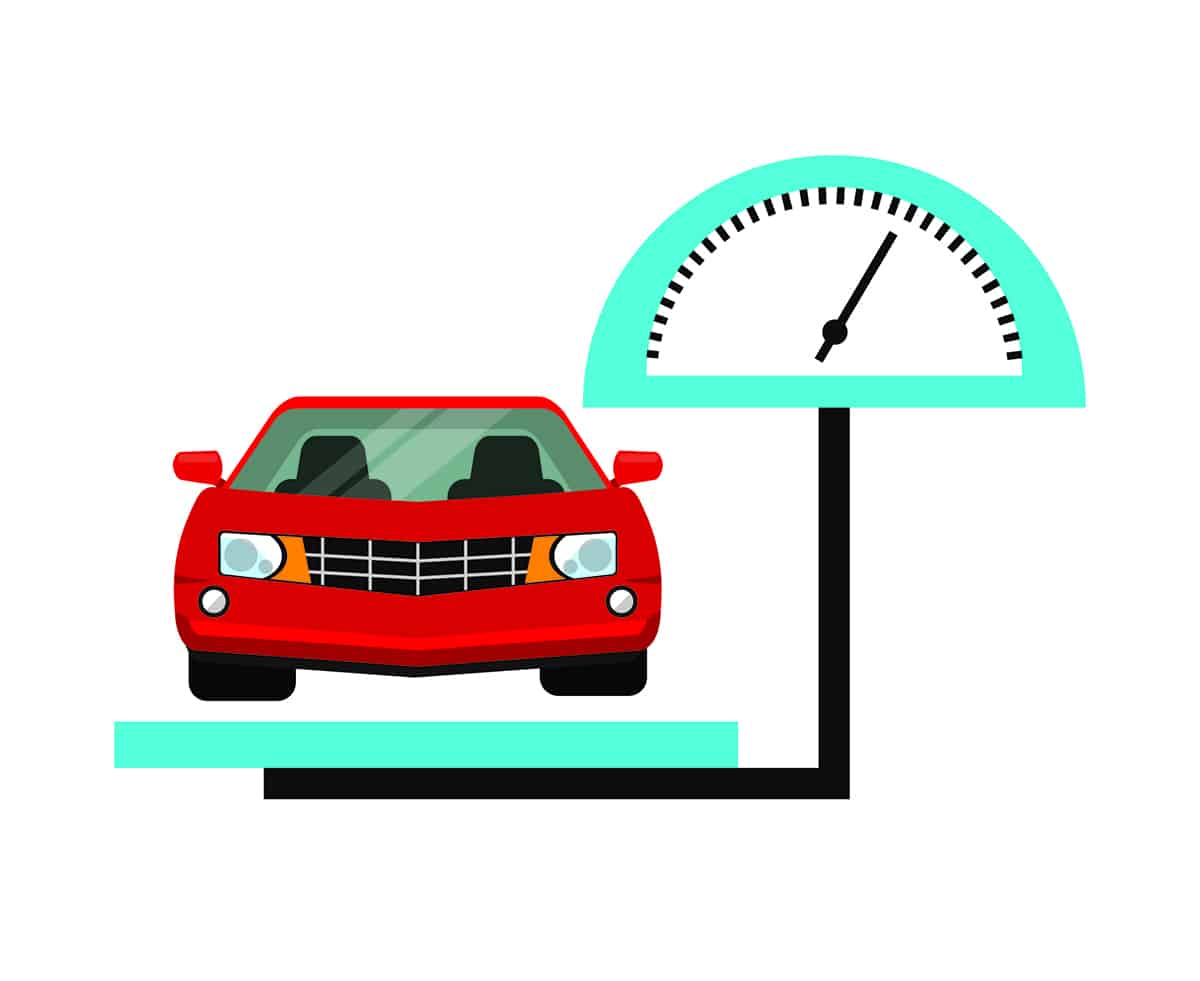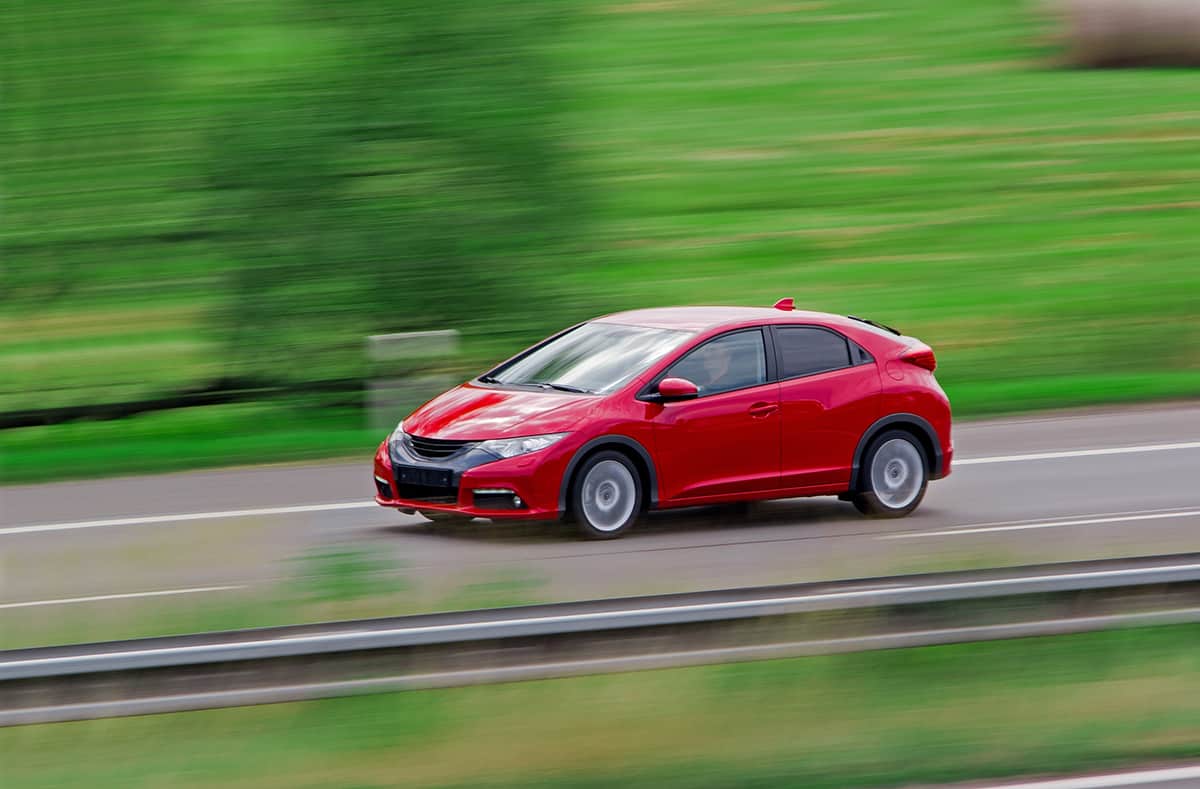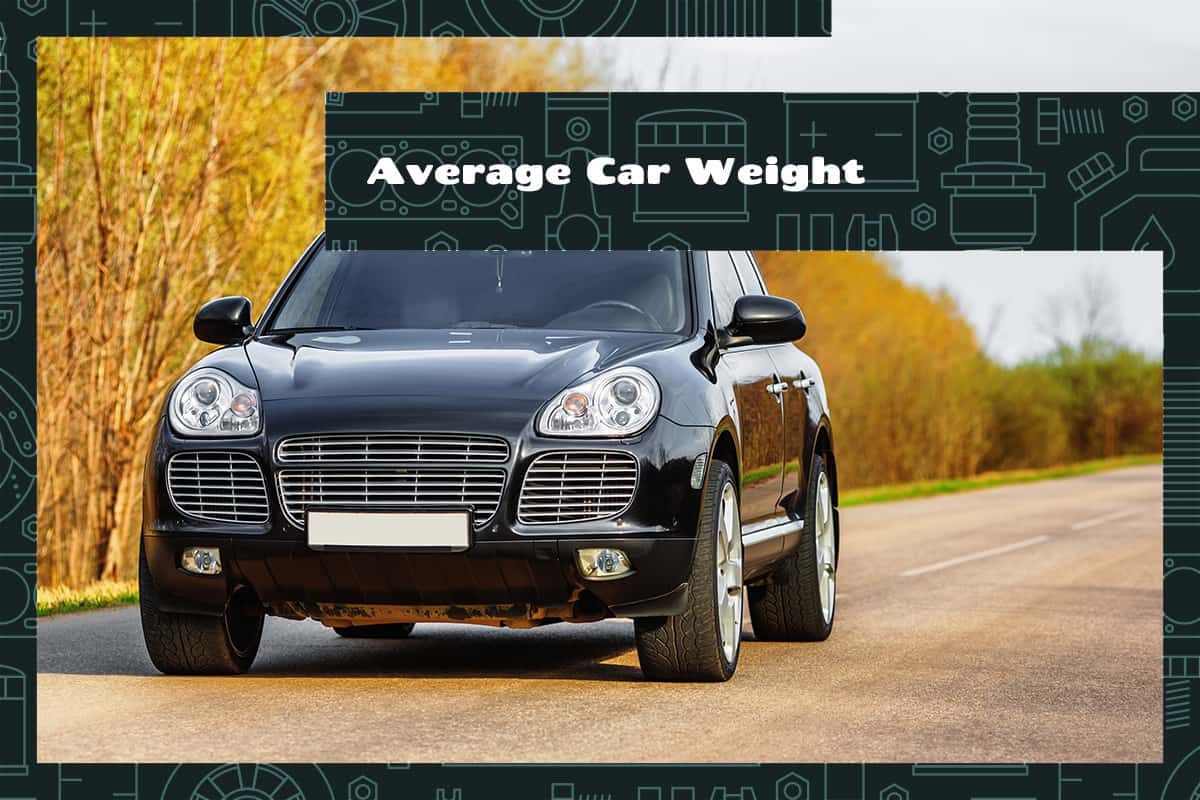If you’re shopping around for a car, weight is probably one of the last things that comes to mind, if at all! So, the next time you go car shopping, you can leave the car dealer scratching their head by asking them how much the typical car weighs.
The 2022 EPA Automotive Trends Report shows that the average car weight in 2021 was 4,289 pounds, with data suggesting that the figure will steadily increase in the future.
In this guide, I’ll provide a more descriptive explanation of car weights based on this report, as well as why the weight of a car even matters.
Average Car Weight per 2022 EPA Automotive Trends Report
Every year, the Environmental Protection Agency publishes the Automotive Trends Report, a comprehensive report concerning information about greenhouse gas emissions, fuel economy, technology data, and performance. Included in the report, specifically in the Vehicle Attributes section, is the average weight of new cars.
If you don’t have time to skim over the 158-page report, allow me to summarize the weight section for you down below.
| Year | Average Weight | Weight Difference from the Previous Year |
| 1975 | 4,060 lbs. | – |
| 1981 | 3,200 lbs. | -21% |
| 2004 | 4,111 lbs. | 28% |
| 2021 | 4,289 lbs. | 4% |
| 2022 | – | – |
It’s important to note that the reported figures were based on inertia weight class, which represents vehicle curb weights plus 300 pounds. For cars weighing less than 2,500 pounds, the vehicle inertia weight was added at 250-pound increments, whereas cars over 3,000 pounds had 500-pound increments added to it.
Average Car Weight by Type
Generally, cars can be split into 5 distinct categories—sedans or wagons, car SUVs, truck SUVs, minivans or vans, and pickups. The following table provides a rough estimate of the average car weight by tape.
| Type | Average Weight |
| Sedans or wagons | ≈ 3,600 lbs. |
| Car SUVs | ≈ 3,700 lbs. |
| Truck SUVs | ≈ 4,500 lbs. |
| Minivans or vans | ≈ 4,600 lbs. |
| Pickups | ≈ 5,250 lbs. |
| All | ≈ 4,400 lbs. |
Examples of Car Weights by Class
Here, we’re going to take a look at different car models from the five types and their actual weights.
1. Sedans or wagons
| Model | Base Weight | Difference from Average Weight for Type (3,600 lbs.) |
| Audi A4 | 3,417 lbs. | -183 lbs. |
| Audi A6 | 3,803 lbs. | 203 lbs. |
| Honda Civic | 2,935 lbs. | -665 lbs. |
| Hyundai Accent | 2,679 lbs. | -921 lbs. |
| Hyundai Elantra | 2,725 lbs. | -875 lbs. |
| Hyundai Veloster | 3,247 lbs. | -353 lbs. |
| Kia Rio | 2,767 lbs. | -833 lbs. |
| Kia Stinger | 3,611 lbs. | 11 lbs. |
| Mazda Mazda3 | 3,100 lbs. | -500 lbs. |
| Mercedes-Benz E-Class | 3,781 lbs. | 181 lbs. |
| Nissan Versa | 2,657 lbs. | -943 lbs. |
| Volkswagen Golf | 3,012 lbs. | -588 lbs. |
| Toyota Corolla | 2,955 lbs. | -654 lbs. |
| Volvo V60 | 3,955 lbs. | 355 lbs. |
| Volvo V90 | 3,897 lbs. | 297 lbs. |
2. Car SUVs
| Model | Base Weight | Difference from Average Weight for Type (3,700 lbs.) |
| BMW X1 | 3,567 lbs. | -133 lbs. |
| BMW X2 | 3,519 lbs. | -181 lbs. |
| BMW X3 | 4,149 lbs. | 449 lbs. |
| Ford Bronco | 4,499 lbs. | 799 lbs. |
| Hyundai Tucson | 3,494 lbs. | -206 lbs. |
| Kia Kona | 3,203 lbs. | -497 lbs. |
| Kia Soul | 2,844 lbs. | -856 lbs. |
| Mazda CX-30 | 3,388 lbs. | -312 lbs. |
| Mazda CX-5 | 3,717 lbs. | 17 lbs. |
| Mercedes-Benz GLC-Class | 3,977 lbs. | 277 lbs. |
| Volvo XC40 | 3,736 lbs. | 36 lbs. |
3. Truck SUVs
| Model | Base Weight | Difference from Average Weight for Type (4,500 lbs.) |
| BMW Alpina XB7 | 5,860 lbs. | 1,360 lbs. |
| Cadillac Escalade | 5,823 lbs. | 1,323 lbs. |
| Chevrolet Suburban | 5,824 lbs. | 1,324 lbs. |
| Chevrolet Tahoe | 5,661 lbs. | 1,161 lbs. |
| GMC Yukon | 4,817 lbs. | 317 lbs. |
| Ford Expedition | 5,306 lbs. | 806 lbs. |
| Jeep Grand Wagoneer | 6,420 lbs. | 1,902 lbs. |
| Jeep Wagoneer | 6,230 lbs. | 1,730 lbs. |
| Lexus LX 600 | 5,665 lbs. | 1,165 lbs. |
| Lincoln Navigator | 6,069 lbs. | 1,569 lbs. |
| Mercedes-Benz GLS-Class | 5,467 lbs. | 967 lbs. |
| Nissan Armada | 5,749 lbs. | 1,249 lbs. |
| Toyota Sequoia | 5,985 lbs. | 1,485 lbs. |
4. Minivans and vans
| Model | Base Weight | Difference from Average Weight for Type (4,600 lbs.) |
| Chrysler Pacifica | 4,521 lbs. | -79 lbs. |
| Chrysler Voyager | 4,330 lbs. | -270 lbs. |
| Ford Transit | 3,685 lbs. | -915 lbs. |
| Ford Transit Connect | 3,689 lbs. | -911 lbs. |
| Honda Odyssey | 4,526 lbs. | -74 lbs. |
| Kia Carnival | 4,411 lbs. | -189 lbs. |
| Mercedes-Benz Metris | 4,850 lbs. | 250 lbs. |
| Mercedes-Benz Sprinter | 5,269 lbs. | 669 lbs. |
| Toyota Sienna | 4,625 lbs. | 25 lbs. |
5. Pickup
| Model | Base Weight | Difference from Average Weight for Type (5,250 lbs.) |
| Chevrolet Colorado | 4,488 lbs. | -762 lbs. |
| Chevrolet Silverado 1500 | 5,000 lbs. | -250 lbs. |
| Ford F-150 | 4,705 lbs. | -545 lbs. |
| Ford Maverick | 3,674 lbs. | -1,576 lbs. |
| GMC Canyon | 4,456 lbs. | -794 lbs. |
| GMC Sierra 1500 | 5,080 lbs. | -170 lbs. |
| Honda Ridgeline | 4,510 lbs. | -740 lbs. |
| Hyundai Santa Cruz | 3,879 lbs. | -1,371 lbs. |
| Isuzu D-Max | 4,464 lbs. | -786 lbs. |
| Jeep Gladiator | 5,050 lbs. | -200 lbs. |
| Nissan Titan | 5,637 lbs. | 387 lbs. |
| Ram 1500 | 5,082 lbs. | -168 lbs. |
| Rivian R1T | 7,150 lbs. | 1,900 lbs. |
| Toyota Tundra | 5,390 lbs. | 680 lbs. |
| Volkswagen Amarok | 4,807 lbs. | -443 lbs. |
Why Does Weight Even Matter in Cars?

While many people may not consider it, the weight of a car plays a crucial role in many factors. Let’s take a closer look at what those factors are.
1. Fuel efficiency
Cars with a higher curb weight need more power to get going. Since they use more gas per mile, their fuel efficiency suffers. Increased fuel consumption means higher fuel costs, which can have a significant impact on long-distance drivers and those who do a lot of driving. Also, heavier vehicles have more trouble getting going, which reduces their MPG. This is why it’s crucial to think about a car’s weight when evaluating its gas mileage.
2. Stopping distance
The stopping distance of a car is directly proportional to its weight. Vehicles with a higher curb weight need more braking force to come to a complete stop. This means they require more room to stop completely. When traveling at high speeds or in an emergency, this can pose a serious threat to the safety of the vehicle and its occupants.
3. Control
Due to their larger mass, heavier cars can be trickier to steer and control in certain driving conditions, such as strong winds or slick roads. Due to the increased mass, the vehicle is more difficult to maneuver.
4. Braking system, suspension system, and tires
Because a heavier vehicle places more strain on the braking system, the suspension, and the tires, these systems are affected by the vehicle’s weight. The braking system will experience more wear and tear due to the increased stopping force needed to stop the vehicle.
Also, the suspension system has to work harder to keep the vehicle stable, which can shorten the lifespan of individual parts. More weight means the tires will experience more wear and tear, reducing their lifespan.
5. Maintenance
When driving a heavier vehicle, more wear and tear is put on the car’s components, increasing maintenance costs. This will result in a rise in the cost of maintenance as a whole, as certain parts will need to be replaced or serviced more frequently.
For instance, a heavier vehicle’s braking system, suspension, and tires will wear out sooner and require more frequent replacement than a lighter vehicle. Cars that weigh more require more effort from the engine, which can increase the frequency of necessary repairs.
In general, the more mass a vehicle has, the more it can cost over time to keep it running smoothly.
6. Safety
There are two ways to look at this. Lighter cars are easier to maneuver and have shorter stopping distances. As such, drivers should have a slightly easier time avoiding collisions or stopping at the correct moments.
The second way to gauge a car’s safety by its weight is by looking at how much “cushioning” it provides. Larger vehicles can be safer since they can come with several more safety features than their compact counterparts. In addition, they provide better crash protection since there’s more in the front, rear, and sides to take the brunt of an impact.
Are 2-Ton Cars Heavy?
The heaviness of a car is relative to its type. For instance, based on the figures above, a 2-ton car (4,000 pounds) would be reasonable for all types except sedans and wagons. Compact cars, including hatchbacks, weigh slightly less than 2 tons—usually around the 1.5-ton figure.
Are Lighter Cars Faster?

Not necessarily. The things that determine how fast a car can travel include the engine, the gear ratio, the aerodynamics, the friction produced by the tires, and the caloric value of the fuel. If all of these variables are identical between 2 cars, then the weight of the vehicle will become a secondary factor.
To demonstrate, let’s compare two vehicles—the Ford F150 and the Jeep Gladiator. The F150 has a top speed of about 110 MPH, while the Jeep Gladiator can reach speeds of up to 130 MPH. Meanwhile, the Gladiator weighs 345 pounds heavier than the F150.
Can You Reduce Car Weight?
There are a few things you can do to reduce the overall weight of your vehicle. This includes removing the spare tire and jack, taking out the air conditioner and heater systems, removing the radio and speakers, removing “unnecessary” interior trim, and the list goes on.
If you do these things, you can expect your car to achieve a higher top speed, though the exact figures depend on how much weight the car has shed.






